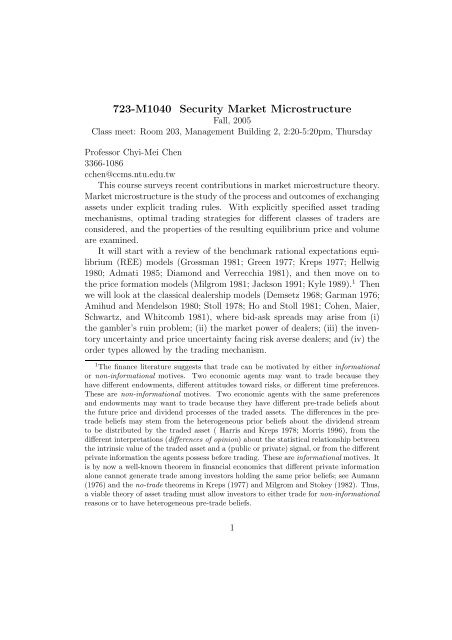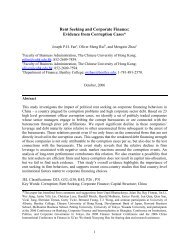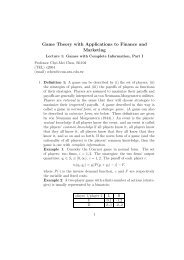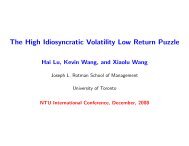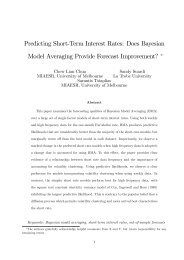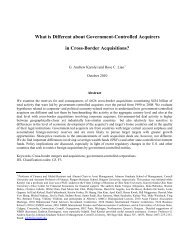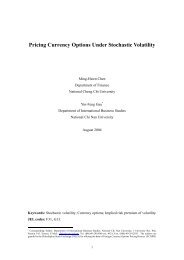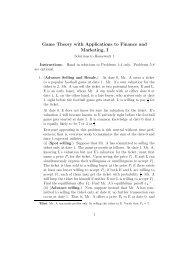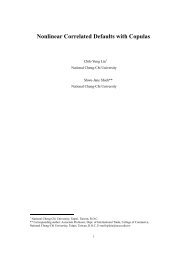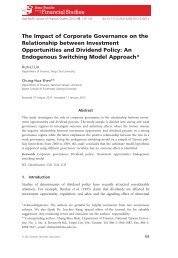723-M1040 Security Market Microstructure
723-M1040 Security Market Microstructure
723-M1040 Security Market Microstructure
Create successful ePaper yourself
Turn your PDF publications into a flip-book with our unique Google optimized e-Paper software.
<strong>723</strong>-<strong>M1040</strong> <strong>Security</strong> <strong>Market</strong> <strong>Microstructure</strong><br />
Fall, 2005<br />
Class meet: Room 203, Management Building 2, 2:20-5:20pm, Thursday<br />
Professor Chyi-Mei Chen<br />
3366-1086<br />
cchen@ccms.ntu.edu.tw<br />
This course surveys recent contributions in market microstructure theory.<br />
<strong>Market</strong> microstructure is the study of the process and outcomes of exchanging<br />
assets under explicit trading rules. With explicitly specified asset trading<br />
mechanisms, optimal trading strategies for different classes of traders are<br />
considered, and the properties of the resulting equilibrium price and volume<br />
are examined.<br />
It will start with a review of the benchmark rational expectations equilibrium<br />
(REE) models (Grossman 1981; Green 1977; Kreps 1977; Hellwig<br />
1980; Admati 1985; Diamond and Verrecchia 1981), and then move on to<br />
the price formation models (Milgrom 1981; Jackson 1991; Kyle 1989). 1 Then<br />
we will look at the classical dealership models (Demsetz 1968; Garman 1976;<br />
Amihud and Mendelson 1980; Stoll 1978; Ho and Stoll 1981; Cohen, Maier,<br />
Schwartz, and Whitcomb 1981), where bid-ask spreads may arise from (i)<br />
the gambler’s ruin problem; (ii) the market power of dealers; (iii) the inventory<br />
uncertainty and price uncertainty facing risk averse dealers; and (iv) the<br />
order types allowed by the trading mechanism.<br />
1 The finance literature suggests that trade can be motivated by either informational<br />
or non-informational motives. Two economic agents may want to trade because they<br />
have different endowments, different attitudes toward risks, or different time preferences.<br />
These are non-informational motives. Two economic agents with the same preferences<br />
and endowments may want to trade because they have different pre-trade beliefs about<br />
the future price and dividend processes of the traded assets. The differences in the pretrade<br />
beliefs may stem from the heterogeneous prior beliefs about the dividend stream<br />
to be distributed by the traded asset ( Harris and Kreps 1978; Morris 1996), from the<br />
different interpretations (differences of opinion) about the statistical relationship between<br />
the intrinsic value of the traded asset and a (public or private) signal, or from the different<br />
private information the agents possess before trading. These are informational motives. It<br />
is by now a well-known theorem in financial economics that different private information<br />
alone cannot generate trade among investors holding the same prior beliefs; see Aumann<br />
(1976) and the no-trade theorems in Kreps (1977) and Milgrom and Stokey (1982). Thus,<br />
a viable theory of asset trading must allow investors to either trade for non-informational<br />
reasons or to have heterogeneous pre-trade beliefs.<br />
1
Then it will consider information-based dealership models, for which the<br />
idea dated back to Bagehot (1971) and was first substantiated by Copeland<br />
and Galai (1983). The information-based models have by now considered<br />
both quote-driven and order-driven mechanisms, where the former was originated<br />
by Golsten and Milgrom (1985) and the latter by Kyle (1985). Both<br />
papers have numerous extensions. Easley and O’Hara (1987; 1992), for example,<br />
extend the sequential trading model of Glosten and Milgrom (1985)<br />
to show that high volume tends to be accompanied by large spreads and that<br />
absence of trade has information content for asset pricing. An important<br />
extension is Bernhardt and Hughson (1997), which allows traders to split<br />
orders among dealers. Kyle’s model has been extended by many authors to<br />
allow for utility maximizing liquidity traders (Spiegel and Subrahmanyam<br />
1991), risk averse insiders (Subrahmanyam 1991), imperfectly competitive<br />
insiders (Holden and Subrahmanyam 1992; Back, Cao, and Willard 2000),<br />
super-informed insider (Rochet and Vila 1994), continuously trading (Back<br />
1992), liquidity traders who have discretion about the timing of trade (Admati<br />
and Pfleiderer 1988), and over-confident insiders (Wang 1998), just to<br />
name a few. Back and Baruch (2002) show that with continuous trading, the<br />
two classes of models described above have their equilibria converge.<br />
It will then consider the several theories that aim at explaining some<br />
well-documented patterns in transaction prices and trading volume (Admati<br />
and Pfleiderer 1988, 1989; Foster and Viswanathan 1990; Spiegel and Subrahmanyam<br />
1992; Pagano 1989; Bernhardt and Hughson 2002; Harris and<br />
Raviv 1993; Campbell, Grossman, and Wang 1993; Wang 1993, 1994; Wang<br />
1998; Varian 1985,1987; Huffman 1987; Chen 1992; Chen and Chen 2003). In<br />
particular, trade tends to cluster either geographically or on certain period<br />
of time, and high volume tends to be accompanied by price rise and by large<br />
absolute price change. It will also take a look at block trading (Easley and<br />
O’Hara 1987; Admati and Pfleiderer 1991; Burdett and O’Hara 1987).<br />
It will next consider the role of investors’ trading horizons in leading to<br />
excessive volatility and a tendency to coordinate on fundamental-unrelated<br />
signals. First dynamic REE models (Brown and Jennings 1989; Grundy and<br />
McNichols 1989; Shalen 1993; He and Wang 1995) will be examined. In partially<br />
revealing REE’s, price and volume together can provide information<br />
to the market in much the same way that a sequence of prices does (Wang<br />
1994). It will then ask how short horizon may affect volatility and herding<br />
(Bhushan, Brown, and Mello 1997; Froot, Scharfstein, and Stein 1992;<br />
2
Holden and Subrahmanyam 1996; Vives 1995; Spiegle). Essentially, a higher<br />
proportion of short-term traders implies a higher price volatility, but this<br />
emphasis on trading horizons should be contrasted with other explanations<br />
for excessive volatility (see Shiller 1981 and West 1988) that are based on<br />
information asymmetry alone (Wang 1993; Allen and Douglas 1994).<br />
It will then examine the roles of various classes of traders. It will start<br />
with noise traders (Black 1986; DeLong, Shleifer, Summers, and Woldmann<br />
1989, 1990a, 1990b, 1991), and then brokers (Jordan and Morgan 1990; Fishman<br />
and Longstaff 1992), and then financial analysts (Trueman 1994; Hirshleifer,<br />
Subrahmanyam and Titman 1994), and finally exchange specialists<br />
(Glosten 1989; Seppi 1997) and the contrast between specialists and imperfectly<br />
competitive market makers (Madhavan 1992; Leach and Madhavan<br />
1992,1993). Unlike with the Walrasian trading mechanism, in the real world,<br />
price discovery is an important issue, and from this perspective a monopolistic<br />
specialist may be preferred (Leach and Madhavan 1993; Madhavan and<br />
Panchapagesan 2000).<br />
It will then consider the possible economic causes for market crash (Grossman<br />
1988; Gennotte and Leland 1990; Jacklin, Kleidon, and Pfleiderer 1992;<br />
Romer 1993; Hong and Stein 1999).<br />
It will next consider the interactions between the underlying asset market<br />
and the derivative asset markets (Biais and Hillion 1994; Kumar, Sarin, and<br />
Shastri 1992; Brennan and Cao 1996; Cao 1999; Bessembinder and Seguin<br />
1992; Back 1993; Subrahmanyam 1991; Chen, Hsieh, and Szu 2001; Bossaerts<br />
on insiders trading portfolios).<br />
Then various market features will be considered. This includes discrete<br />
pricing (Anshuman and Kalay 1998; Bernhardt and Hughson 1996; Harris<br />
1991), a limit set of order forms (Easley and O’Hara 1991; Chakravarty and<br />
Holden 1995; Han and Chen 2000), mandatory trade disclosure regulation<br />
(Madhavan 1995; Han and Chen 2003; Fishman and Hagerty 1995), one or<br />
multiple market makers (Leach and Madhavan 1992,1993), short sale constraints<br />
(Diamond and Verrecchia 1987), call or continuous markets (Madhavan<br />
1992), transparency (Bikhchandani and Huang 1989; Chen, Hsu and<br />
Wang 2003; Madhavan 1995; Glosten 1999; Bloomfield and O’Hara 1999;<br />
Flood, Huisman, Koedijk and Mahieu 1999), and price limits (Chen 1994;<br />
Kodres and O’Brien 1994).<br />
Then, it will consider market manipulation by uninformed traders (Kumar<br />
and Seppi 1992; Allen and Gale 1992) and by informed traders (Vila<br />
3
1986; Benabou and Laroque 1992).<br />
Then it will consider models that involve trade occurring in more than<br />
one market (Chowdhry and Nanda 1991; Biais 1993; Leach and Madhavan<br />
1993, Pagano 1989b; Subrahmanyam 1991).<br />
Finally, we will review the pros and cons of insider trading from the<br />
society’s perspective (Leland 1992, Manove 1989; Laffont and Maskin 1990;<br />
Ausubel 1990; Bagnoli and Khanna 1992; Fischer 1992; Khanna, Slezak, and<br />
Bradley 1994; Bernhardt, Hollifield, and Hughson 1995; Faure-Grimaud and<br />
Gromb 1999).<br />
Students are responsible for presenting part of the listed articles below.<br />
• 9/22 Introduction and the REE Models. Lecture note.<br />
• 9/29 1. Inventory Models.<br />
1. Amihud, Y. and H. Mendelson, 1980, Dealership <strong>Market</strong>: <strong>Market</strong><br />
Making with Inventory, JFE 8, 31-53.<br />
2. Cohen, K., S. Maier, R. Schwartz, and D. Whitcomb, 1981, Transaction<br />
Costs, Order Placement Strategy, and Existence of Bid-Ask<br />
Spread, JPE 89, 287-305.<br />
3. Demsetz, H., 1968, The Cost of Transacting, OJE 82, 33-53.<br />
4. Garman, M., 1976, <strong>Market</strong> <strong>Microstructure</strong>, JFE 3, 257-275.<br />
5. Ho, T. and H. Stoll, 1981, Optimal Dealer Pricing under Transactions<br />
and Return Uncertainty, JFE 9, 47-73.<br />
6. Stoll, H., 1978, The Supply of Dealer Services in Securities <strong>Market</strong>s,<br />
JF 33, 1131-1151.<br />
• 9/29 2. Information-Based Models.<br />
1. Copeland, T. and D. Galai, 1983, Information Effects and the<br />
Bid-Ask Spread, JF 38, 1457-1469.<br />
2. Easley, D. and M. O’Hara, 1987, Price, Trade Size, and Information<br />
in Securities <strong>Market</strong>s, JFE 19, 69-90.<br />
3. Glosten, L. and P. Milgrom, 1985, Bid, Ask, and Transction Prices<br />
in a Specialist <strong>Market</strong> with Heterogeneously Informed Traders,<br />
JFE 13, 71-100.<br />
4
4. Kyle, A., 1985, Continuous Auctions and Insider Trading, Econometrica<br />
53, 1315-1336.<br />
• 10/6 1. Insider Trading.<br />
1. Back, K., 1992, Insider Trading in Continuous Time, RFS 5, 387-<br />
410.<br />
2. Kyle, A., 1985, Continuous Auctions and Insider Trading, Econometrica<br />
53, 1315-1336.<br />
• 10/13 2. Multiple Insiders.<br />
1. Back, K., Cao, H., and G. Willard, 2000, Imperfect competition<br />
among informed traders, Journal of Finance 55, 2117V2155.<br />
2. Holden, C.W. and A. Subrahmanyam, 1992, Long-Lived Private<br />
Information and Imperfect Competition, JF 47, 247-270.<br />
3. Kyle, A., 1989, Informed Speculation with Imperfect Competition,<br />
RES 56, 317-355.<br />
• 10/20 Uninformed Traders.<br />
1. Admati, A. and P. Pfleiderer, 1988, A Theory of Intraday Patterns:<br />
Volume and Price Variability, RFS 1, 3-40.<br />
2. Admati, A. and P. Pfleiderer, 1989, Divide and Conquer: A Theory<br />
of Intraday and Day-of-the-Week Mean Effects, RFS 2, 189-<br />
224.<br />
3. Foster, F. and S. Viswanathan, 1990, A Theory of the Intraday<br />
Variations in Volume, Variance and Trading Costs in Securities<br />
<strong>Market</strong>s, RFS 3, 593-624.<br />
4. Spiegel, M. and A. Subrahmanyam, 1992, Informed Speculation<br />
and Hedging in a Noncompetitive Securities <strong>Market</strong>, RFS 5, 307-<br />
330.<br />
• 10/27 Technical Analysis.<br />
1. Brown, D. and R. Jennings, 1989, On Technical Analysis, RFS 2,<br />
527-552.<br />
5
2. Lo, A., H. Mamaysky, and J. Wang, 2000, Foundations of technical<br />
analysis: computational algorithms, statistical inference, and<br />
empirical implementation, JF, 55, 1705-1765.<br />
3. Neftci, S., 1991, Naive trading rules in financial markets and<br />
Weiner-Kolmogorov prediction theory: a study of technical analysis,<br />
JB, 64, 549-571.<br />
• 11/3 Trading Volume and Price Adjustment.<br />
1. Harris, M. and A. Raviv, 1993, Differences of Opinion Make a<br />
Horse Race, RFS 6, 473-506.<br />
2. Wang, J., 1994, A Model of Competitive Stock Trading Volume,<br />
JPE 102, 127-168.<br />
3. Easley, D. and M. O’Hara, 1992, Time and the Process and <strong>Security</strong><br />
Price Adjustment, JF 47, 577-606.<br />
4. Grundy, B. and M. McNichols, 1989, Trade and Revelation of<br />
Information Through Prices and Direct Disclosure, RFS 2, 495-<br />
526.<br />
• 11/10 Block trading.<br />
1. Admati, A. and P. Pfleiderer, 1991, Sunshine Trading and Financial<br />
<strong>Market</strong> Equilibrium, RFS 4, 443-482.<br />
2. Burdett, K. and M. O’Hara, 1987, Building Blocks: An Introduction<br />
to Block Trading, J. Banking and Finance 11, 193-212.<br />
3. Grossman, S., 1990, The Information Role of Unstairs and Downstairs<br />
Trading, working paper, Wharton.<br />
• 11/17 <strong>Market</strong> Viability,<br />
1. Glosten, L., 1989, Insider Trading, Liquidity, and the Role of Monopolist<br />
Specialist, JB 62, 211-236.<br />
2. Madhavan, A., 1992, Trading Mechanisms in Securities <strong>Market</strong>s,<br />
JF 47, 607-642.<br />
• 11/24 <strong>Market</strong> Crash.<br />
6
1. Gennotte, G. and H. Leland, 1990, <strong>Market</strong> Liquidity, Hedges and<br />
Crashes, AER 80, 999-1021.<br />
2. Grossman, S., 1988, An Analysis of the Implications for Stock<br />
and Futures: Price Volatility of Program Trading and Dynamic<br />
Hedging Strategies, JB 61, 275-298.<br />
3. Jacklin, C., A. Kleidon, and P. Pfleiderer, 1992, Underestimation<br />
of Portfolio Insurance and the Crash of October 1987, RFS 5,<br />
35-63.<br />
• 12/1 Trading via Multiple <strong>Market</strong>s.<br />
1. Brennan, M., and H. Cao, 1996, Information, trade, and derivative<br />
securities, RFS, 9, 163-208.<br />
2. Chowdhry, B. and V. Nanda, 1991, Multi-<strong>Market</strong> Trading and<br />
<strong>Market</strong> Liquidity, RFS 3, 483-511.<br />
3. Madhavan, A., 1995, Consolidation, fragmentation, and the disclosure<br />
of trading information, RFS, 8, 579-603.<br />
• 12/8, 12/15 Imperfections and <strong>Market</strong> Volatility.<br />
1. Anshuman, V.R. and A. Kalay, 1998, <strong>Market</strong> making with discrete<br />
prices, RFS, 11, 81-109.<br />
2. Chakravarty, S., 1995, An integrated model of market and limit<br />
orders, Journal of Financial Intermediation, vol. 4.<br />
3. Diamond, D. and R. Verrecchia, 1987, Constraints on Short-Selling<br />
and Asset Price Adjustments to Private Information, JFE 18, 277-<br />
311.<br />
4. Ferris, S., and S. Don Chance, 1988, Margin requirements and<br />
stock price volatility, Economic Letters, 28, 251-254.<br />
5. Flavin, M., 1983, Excess volatility in financial markets: a reassessment<br />
of the empirical evidence, J. Political Economy, 91, 929-956.<br />
6. Hsieh, D. and M. Miller, 1990, Margin requirements and stock<br />
price volatility, JF, 45, 3-29.<br />
7. Kodres, L. and D. O’Brien, 1994, The Existence of Pareto Superior<br />
Price Limits, American Economic Review, 84, 919-932.<br />
7
8. Kupiec, P. and S. Sharpe, 1991, Animal spirits, margin requirements,<br />
and stock price volatility, JF, 46, 717-731.<br />
• 12/22 Short Horizon.<br />
1. Vives, X., 1995, Short-term investment and the informational efficiency<br />
of the market, RFS, 8, 125-160.<br />
2. Stein, J., 1988, Takeover threats and managerial myopia, J. Political<br />
Economy, 96, 61-79.<br />
3. Stein, J., 1989, Efficient capital markets, inefficient firms: a model<br />
of myopic corporate behavior, QJE, 654-669.<br />
4. Bhushan, R., D. Brown, and A. Mello, 1991, Investor horizon and<br />
noise in asset prices, working paper, MIT.<br />
5. Shleifer, A., and R. Vishny, 1990, Equilibrium short horizons of<br />
investors as firms, AER, 80, 148-153.<br />
6. Narayanan, M., 1985, Observability and the payback criterion, J.<br />
Business, 58, 309-323.<br />
7. Faure-Grimaud, A., and D. Gromb, 1999, Trading, voice and exit<br />
over the firm’s life cycle, working paper, MIT.<br />
8. Holden, C., and A. Subrahmanyam, 1996, Risk aversion, liquidity,<br />
and endogenous short horizon, RFS, 9, 691-722.<br />
• 12/29 Empirical Evidence for Volume.<br />
1. Gallant, A., P. Rossi, and G. Tauchen, 1992, Stock prices and<br />
volume, RFS, 5, 199-242.<br />
2. Jain, P., and G. Joh, 1988, The dependence between hourly prices<br />
and trading volume, JFQA, 23, 269-283.<br />
3. McInish, T., and R. Wood, 1992, An analysis of intraday patterns<br />
in bid/ask spreads for NYSE stocks, JF, 47, 753-764.<br />
4. McInish, T., and R. Wood, 1995, Hidden limit orders on the<br />
NYSE, J. Portfolio Management, 19-26.<br />
5. Karpoff, J., 1987, The relationship between price changes and<br />
trading volume: a survey, JFQA, 22, 109-126.<br />
8
6. Gerety, M., and J. H. Mulherin, 1994, Price formation on stock<br />
exchanges: the evolution of trading within the day, RFS, 7, 609-<br />
629.<br />
7. Kumar, R., A. Sarin, and K. Shastri, 1992, The behavior of option<br />
price around large block transactions in the underlying security,<br />
JF, 47, 879-889.<br />
8. Blume, M., A. C. Mackinlay, and B. Terker, 1989, Order imbalances<br />
and stock price movements on October 19 and 20, 1987, JF,<br />
44, 827-.<br />
• 1/5 Herding.<br />
1. Hirshleifer, D., A. Subrahmanyam, and S. Titman, 1994, <strong>Security</strong><br />
analysis and trading patterns when some investors receive information<br />
before others, JF, 49, 1665-1697.<br />
2. Scharfstein, D. and J. Stein, 1990, Herd behavior and investment,<br />
AER, 80, 465-479.<br />
3. Bikhchandani, S., D. Hirshleifer, and I. Welch, , A theory of fads,<br />
fashion, custom, and cultural change as information cascades, J.<br />
Political Economy, 100, 992-1026.<br />
4. Banerjee, A., 1992, A simple model of herd behavior, QJE, 107,<br />
797-818.<br />
• 1/12 Final Exam.<br />
9


